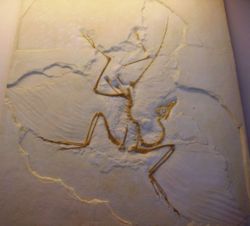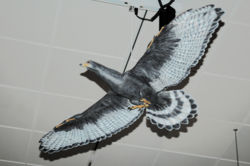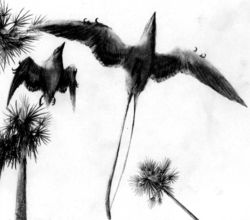
A cast of the Berlin specimen of
Archaeopteryx, the most famous
prehistoric bird.
Birds evolved from
feathered dinosaurs and there is no real dividing line
between birds and dinosaurs, except of course that the
former survived the Cretaceous-Tertiary extinction event and the latter did
not. For the purposes of this article, a 'bird' is
considered to be any member of the clade
Aves. Some dinosaur groups which may or may not be true
birds are listed below under 'Proto-birds'.
This page contains a listing of prehistoric bird taxa
only known from completely fossilized specimens. These
extinctions took place before the Late Quaternary and thus
took place in the absence of human interference. Rather,
reasons for extinction are stochastic abiotic events such as
bolide impacts, climate change due to orbital shifts, mass
volcanic eruptions etc. Alternatively, species may have gone
extinct due to evolutionary displacement by successor or
competitor taxa - it is notable that an extremely large
number of seabirds have gone extinct during the
mid-Tertiary; this is probably due to competition by the
contemporary radiation of marine mammals. The relationships
of these taxa are often hard to determine, as many are known
only from very fragmentary remains and due to the complete
fossilization precluding analysis of information from DNA,
RNA or protein sequencing. The taxa listed in this article
should be classified with the Wikipedia conservation status
category "Fossil".
Taxonomic List of Fossil Prehistoric Birds
Extinct genera are presented in ascending chronological
order. Extinct forms of extant
genera are sorted alphabetically by genus first, then
chronologically.
The higher-level groups of non-Neornithes
are arranged after Chiappe (2001, 2002), updated and
expanded to incorporate recent research. These categories
are inclusive in ascending order: e.g., every basal
pygostylian is a member of the Aves (but more advanced than
"basal Aves"), etc.
Please be aware that taxonomic assignments,
especially in the pygostylian to early neornithine genera,
are still very provisional and subject to quite frequent
change.
†"Proto-birds"
This category contains very early fossils that some
consider the earliest evidence of birds and others which are
generally agreed to be
theropods but the placement of which in regard to birds is
controversial, with most scientists consider them closely
related to birds and others avian enough to include in the
latter. In any case, these forms demonstrate that feathered
wings were not limited to true birds, but evolved
independently in several related lineages of theropods
- Protoavis (Late Triassic) - a nomen dubium
Palaeopteryx (Late Jurassic) - a nomen dubium
-
Alvarezsauridae
- Shuvuuia (Late Cretaceous)
-
Oviraptorosauria
-
Caudipteryx (Early Cretaceous)
-
Scansoriopterygidae
-
Epidendrosaurus (Early Cretaceous)
-
Troodontidae
-
Dromaeosauridae
-
Rahonavis (Late Cretaceous)
-
Yandangornis

Model of Sapeornis chaoyangensis, a
short-legged Early Cretaceous bird the size of a
large grouse which probably fed on fruit and
nuts.
The most primitive birds, usually still possessing a long
bony tail with generally unfused vertebrae.
- Unresolved forms
- Dalianraptor (Jiufotang Early Cretaceous of
Liaoning, China)
Hebeiornis (Yixian? Early Cretaceous? of Hebei,
China)
Jixiangornis (Early Cretaceous)
Shenzhouraptor (Early Cretaceous)
Hulsanpes (Late Cretaceous)
-
Archaeopterygidae
- Archaeopteryx (Late Jurassic)
Wellnhoferia (Late Jurassic) - may be synonym of
Archaeopteryx
Omnivoropterygiformes
-
Omnivoropterygidae
-
Omnivoropteryx (Early Cretaceous)
- Sapeornis (Jiufotang Early Cretaceous of
Chaoyang City, China)
†Basal
Pygostylia

Reconstruction of two
Confuciusornis in flught, showing their
strange wing shape.
The earliest birds with a modern
pygostyle: a reduction and fusion of the tail vertebrae.
- Placement unresolved
-
Abavornis (Late Cretaceous) -
enantiornithine?
- Catenoleimus
- Explorornis
- Incolornis
-
Confuciusornithidae
- Proornis (Sinniju Late Jurassic/Early
Cretaceous of Sinnuiju City, North Korea)
- Changchengornis (Early Cretaceous of
Chaomidianzi, China)
-
Confuciusornis (Early Cretaceous)
- Jinzhouornis
†Enantiornithes
"Opposite Birds" due to the way their foot bones are
fused; an extinct
Mesozoic sub-class.
- Unresolved and basal forms
- Concornis (Early Cretaceous)
- Cuspirostrisornis (Early Cretaceous)
- Eoenantiornis (Early Cretaceous)
- Jibeinia (Early Cretaceous) - a
nomen dubium
- Largirostrornis (Early Cretaceous)
- Liaoxiornis (Early Cretaceous)
- Longchengornis (Early Cretaceous)
- Longipteryx (Early Cretaceous)
- Longirostravis (Early Cretaceous)
- Vescornis (Early Cretaceous)
- Enantiornithes gen. et sp. indet.
CAGS−IG−02−0901 (Early Cretaceous)
- Enantiornithes gen. et sp. indet.
CAGS−IG−04−CM−007 (Early Cretaceous)
- Eoalulavis (Middle Cretaceous)
- Halimornis (Late Cretaceous)
- Kizylkumavis (Late Cretaceous)
- Lenesornis (Late Cretaceous)
- Sazavis (Late Cretaceous)
- Gurilynia (Late Cretaceous) -
enantiornithiform?
- Yungavolucris (Late Cretaceous) -
enantiornithiform (avisaurid)?
- Enantiornithes gen. et sp. indet. MCSNM V3882a
(Late Cretaceous)
- Enantiornithes gen. et sp. indet.
RBCM.EH2005.003.0002 (Late Cretaceous)
- Aberratiodontus
- Alexornis
- Dapingfangornis
-
Kuszholiidae
-
Kuszholia (Late Cretaceous)
Iberomesornithiformes
-
Iberomesornithidae
-
Iberomesornis (Early Cretaceous)
- Noguerornis (Early Cretaceous)
Cathyornithiformes
-
Cathayornithidae
- Boluochia (Early Cretaceousa)
- Cathayornis (Early Cretaceous) - includes
Sinornis
- Eocathayornis
Gobipterygiformes
-
Gobipterygidae
-
Gobipteryx (Late Cretaceous)
Enantiornithiformes
- Placement unresolved
- Lectavis (Late Cretaceous) - avisaurid?
-
Enantiornithidae
-
Enantiornis (Late Cretaceous)
-
Zhyraornithidae
- Zhyraornis (Late Cretaceous)
-
Avisauridae
-
Avisaurus (Late Cretaceous)
- Neuquenornis (Late Cretaceous)
- Soroavisaurus (Late Cretaceous)
†Basal
Ornithurae
Essentially modern birds, except many still possess a few
primitive features such as teeth or wing claws.
- Unresolved and basal forms
-
Gansus (Early Cretaceous) - basal
- Apsaravis (Djadokhta Late Cretaceous of
Ukhaa Tolgod, Mongolia)
- Archaeorhynchus (Early Cretaceous of
Liaoning, China)
- Limenavis (Allen Late Cretaceous of
Salitral Moreno, Argentina)
- "cf. Parahesperornis" (Nemegt Late
Cretaceous of Tsagaan Kushu, Mongolia) -
hesperornithiform?
- Carinatae gen. et sp. indet. NHMM/RD 271
(Maastricht Late Cretaceous, CBR-Romontbos Quarry,
Belgium) - ichthyornithine?
- Ornithurae gen. et sp. indet.
RBCM.EH2005.003.0001 (Northumberland Late Cretaceous
of Hornby Island, Canada)
- Ornithurae gen. et sp. indet. TMP 98.68.145
(Dinosur Park Late Cretaceous of Iddesleigh, Canada)
- hesperornithiform?
-
Ambiortidae
- Ambiortus (Early Cretaceous of Mongolia)
Yanornithiformes
-
Songlingornithidae
- Songlingornis (Jiufotang Early Cretaceous
of Liaoning, China)
-
Yanornis (Jiutotang Early Cretaceous of
Chaoyang City, China)
- Yixianornis (Jiufotang Early Cretaceous
of Chaoyang City, China)
†Hesperornithes

Skull of a
Hesperornis with the unique teeth.
Large, toothed,
loon-like diving birds.
- Unresolved and basal forms
- Hesperornithiformes gen. et sp. indet. (Late
Cretaceous)
- Hesperornithiformes gen. et sp. indet. TMP
89.81.12 (Late Cretaceous)
- Judinornis (Late Cretaceous)
- Potamornis (Late Cretaceous) -
hesperornithid?
- Pasquiaornis
-
Enaliornithidae
- Enaliornis (Early Cretaceous)
-
Baptornithidae
-
Baptornis (Late Cretaceous)
-
Hesperornithidae
-
Hesperornis (Late Cretaceous)
- Parahesperornis (Late Cretaceous)
- Canadaga
- Coniornis
†Ichthyornithes
Toothed birds similar to modern
gulls.
-
Ichthyornidae
-
Ichthyornis (Late Cretaceous)




